Related Research Articles
Control theory is a field of control engineering and applied mathematics that deals with the control of dynamical systems in engineered processes and machines. The objective is to develop a model or algorithm governing the application of system inputs to drive the system to a desired state, while minimizing any delay, overshoot, or steady-state error and ensuring a level of control stability; often with the aim to achieve a degree of optimality.
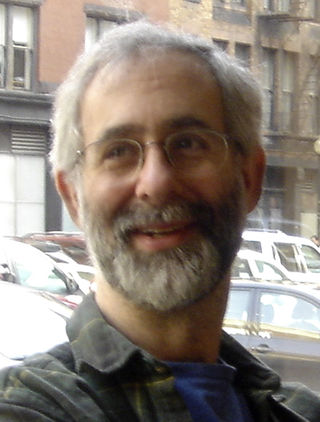
Daniel Singer Bricklin is an American businessman and engineer who is the co-creator, with Bob Frankston, of VisiCalc, the first spreadsheet program. He also founded Software Garden, Inc., of which he is currently president, and Trellix, which he left in 2004. He currently serves as the chief technology officer of Alpha Software.
A mathematical model is an abstract description of a concrete system using mathematical concepts and language. The process of developing a mathematical model is termed mathematical modeling. Mathematical models are used in applied mathematics and in the natural sciences and engineering disciplines, as well as in non-physical systems such as the social sciences. It can also be taught as a subject in its own right.

Numerical analysis is the study of algorithms that use numerical approximation for the problems of mathematical analysis. It is the study of numerical methods that attempt to find approximate solutions of problems rather than the exact ones. Numerical analysis finds application in all fields of engineering and the physical sciences, and in the 21st century also the life and social sciences like economics, medicine, business and even the arts. Current growth in computing power has enabled the use of more complex numerical analysis, providing detailed and realistic mathematical models in science and engineering. Examples of numerical analysis include: ordinary differential equations as found in celestial mechanics, numerical linear algebra in data analysis, and stochastic differential equations and Markov chains for simulating living cells in medicine and biology.
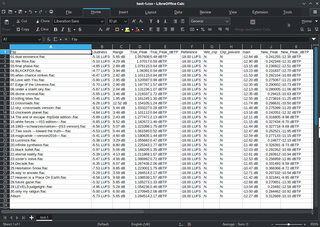
A spreadsheet is a computer application for computation, organization, analysis and storage of data in tabular form. Spreadsheets were developed as computerized analogs of paper accounting worksheets. The program operates on data entered in cells of a table. Each cell may contain either numeric or text data, or the results of formulas that automatically calculate and display a value based on the contents of other cells. The term spreadsheet may also refer to one such electronic document.
Metafont is a description language used to define raster fonts. It is also the name of the interpreter that executes Metafont code, generating the bitmap fonts that can be embedded into e.g. PostScript. Metafont was devised by Donald Knuth as a companion to his TeX typesetting system.

Maple is a symbolic and numeric computing environment as well as a multi-paradigm programming language. It covers several areas of technical computing, such as symbolic mathematics, numerical analysis, data processing, visualization, and others. A toolbox, MapleSim, adds functionality for multidomain physical modeling and code generation.

The HP-22S is an electronic calculator from the Hewlett-Packard company which is algebraic and scientific. This calculator is comparable to the HP-32S. A solver was included instead of programming. It had the same constraints as the 32S, lacking enough RAM for serious use. Functions available include TVM and unit conversions. Only single letter variable names are allowed. Marketed as a student calculator, the 22S uses infix notation rather than the reverse polish notation used on some higher-end HP calculators of the same era.

Mathcad is computer software for the verification, validation, documentation and re-use of mathematical calculations in engineering and science, notably mechanical, chemical, electrical, and civil engineering. Released in 1986 on DOS, it introduced live editing (WYSIWYG) of typeset mathematical notation in an interactive notebook, combined with automatic computations. It was originally developed by Mathsoft, and since 2006 has been a product of Parametric Technology Corporation.
Software Arts was a software company founded by Dan Bricklin and Bob Frankston in 1979 to develop VisiCalc, which was published by a separate company, Personal Software Inc., later named VisiCorp.
A problem solving environment (PSE) is a completed, integrated and specialised computer software for solving one class of problems, combining automated problem-solving methods with human-oriented tools for guiding the problem resolution. A PSE may also assist users in formulating problem resolution. A PSE may also assist users in formulating problems, selecting algorithm, simulating numerical value and viewing and analysing results.

Mathomatic is a free, portable, general-purpose computer algebra system (CAS) that can symbolically solve, simplify, combine and compare algebraic equations, and can perform complex number, modular, and polynomial arithmetic, along with standard arithmetic. It can perform symbolic calculus (derivative, extrema, Taylor series, and polynomial integration and Laplace transforms), numerical integration, and can handle all elementary algebra except logarithms. Trigonometric functions can be entered and manipulated using complex exponentials, with the GNU m4 preprocessor. Not currently implemented are general functions such as f(x), arbitrary-precision and interval arithmetic, as well as matrices.
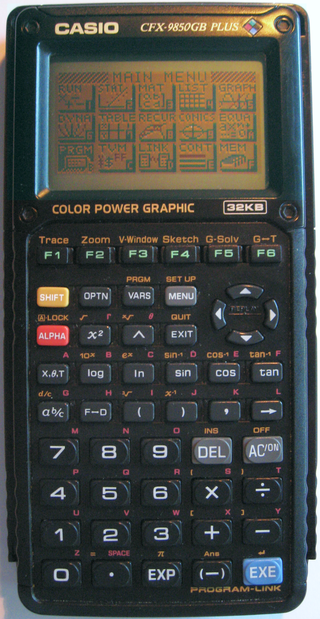
The Casio CFX-9850G series is a series of graphing calculators manufactured by Casio Computer Co., Ltd. from 1996 to 2008.
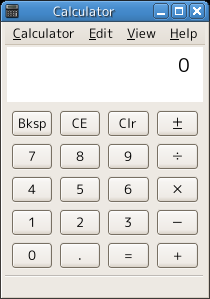
A software calculator is a calculator that has been implemented as a computer program, rather than as a physical hardware device.
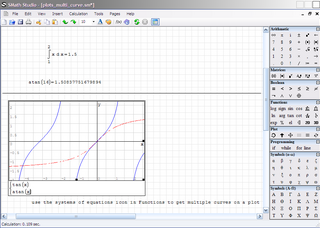
SMath Studio is a freeware, closed-source, mathematical notebook program similar to Mathcad. It is available for Windows, Linux, iOS, Android, Universal Windows Platform, and on some handhelds.
Engineering Equation Solver (EES) is a commercial software package used for solution of systems of simultaneous non-linear equations. It provides many useful specialized functions and equations for the solution of thermodynamics and heat transfer problems, making it a useful and widely used program for mechanical engineers working in these fields. EES stores thermodynamic properties, which eliminates iterative problem solving by hand through the use of code that calls properties at the specified thermodynamic properties. EES performs the iterative solving, eliminating the tedious and time-consuming task of acquiring thermodynamic properties with its built-in functions.
PROSE was the mathematical 4GL virtual machine that established the holistic modeling paradigm known as Synthetic Calculus. A successor to the SLANG/CUE simulation and optimization language developed at TRW Systems, it was introduced in 1974 on Control Data supercomputers. It was the first commercial language to employ automatic differentiation (AD), which was optimized to loop in the instruction-stack of the CDC 6600 CPU.
This glossary of computer science is a list of definitions of terms and concepts used in computer science, its sub-disciplines, and related fields, including terms relevant to software, data science, and computer programming.
References
- 1 2 3 4 5 6 Erik Sandberg-Diment (August 2, 1983). "New software for science and engineering". The New York Times . Retrieved July 23, 2019.
- 1 2 "Briefs: Lotus sold its TKSolver software program to Universal Technical Systems". The New York Times . January 1, 1986.
- 1 2 David E. Sanger (April 9, 1985). "Lotus Set to Acquire Software Arts". The New York Times .
- ↑ Erik Sandberg-Diment (August 9, 1983). "Ready-to-use formulas for finance to physics". The New York Times .
- ↑ "TK Solver R5". Springs. Spring Manufacturers Institute. Summer 2012.
- 1 2 "TK Solver 5.0 Premium (Standalone) from Universal Technical Systems". uts.com. Retrieved April 20, 2017.
- ↑ /M for move, /I for insert ... "carried over from Visicalc."
- 1 2 3 Nirmala Khandan (2001). Modeling Tools for Environmental Engineers and Scientists. CRC Press. ISBN 1420003399.
- ↑ "Universal Technical Systems' TK! Solver Plus". PC Magazine . March 14, 1989. p. 310.
There is much to admire in Universal Technical Systems' $395 TK! Solver Plus ...
- ↑ Williams, Gregg (October 1982). "Software Arts' TK Solver". BYTE. pp. 360–376. Retrieved December 30, 2024.
- ↑ Miller, Alan R. (December 1984). "TK!Solver". BYTE. pp. 263–272.
- ↑ Ronald Shone, "Software for Solving Equations: Eureka: The Solver, TK Solver Plus and Mathcad", Journal of Economic Surveys3:1:83–95 doi : 10.1111/j.1467-6419.1989.tb00059.x (March 1989)
- ↑ "Mathcad, by Mathsoft Inc. of Cambridge, Mass.; Eureka, by Borland International of Scotts Valley, Calif.
- 1 2 Andrew Pollack (June 24, 1988). "A Top Scientist's Latest: Math Software". The New York Times .